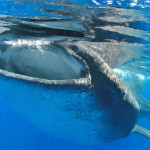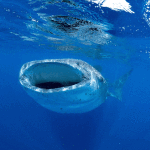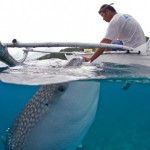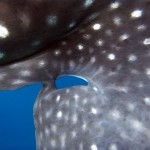Every year, the world’s largest fish gathers to feed (and feed, and FEED) in the Mexican state of Quintana Roo in eastern Yucatan, in numbers larger than those seen anywhere else in the world. But there’s more happening in Quintana Roo than whale sharks, amazing as they are, and these other natural marvels show that the region is a tremendously important hot spot of biological diversity, and one worth concerted conservation efforts. Yesterday was a good example.
My colleague Rafael de la Parra is the executive director of Ch’ooj Ajauil (Mayan for “Blue Realm”), a long time research partner of Georgia Aquarium and an excellent naturalist; he knows more about whale sharks in this area than anyone, and he’s a dab hand with marine mammals and other pelagic (in the water column, i.e. not on the bottom) species as well. We headed out on Rafa’s boat, Grampus, for a day of whale shark photo identification in the waters east of Isla Contoy, an insular national park about 20 miles north-north-east of Cancun. The wind and waves were against us and I didn’t have high hopes; indeed, the Harbor Master only opened the harbor for small boat activity at the last minute. It was a predictably long and sloppy ride to the area of interest, but along the way I was encouraged to see some turtles (las tortugas), a curious group of spotted dolphins (delfin) and an abundance of flying fish (pez volador). Eventually we reached a small flotilla of ecotourism boats, which gather as predictably around whale sharks as the frigate birds do above schools of baitfish.

Despite the conditions it turned out to be a truly magical day! The whale sharks, perhaps 70-100 of them, were clustered especially tightly and it was not unusual to put your mask under the water and be able to see three or four simultaneously. In fact, it makes it hard to get good photo ID images, because they are just coming too thick and fast, which I guess is a good problem to have on any day!

The ecotour boats gradually petered away until we were left alone to snorkel with the animals in the vast expanse of the offshore waters of the warm clear Caribbean. I love it when it’s like that, because without distractions for us or the animals, behaviours are more normal and your eyes gradually open to all the other things that are going on around you. And that’s when you realise that this patch of ocean, seemingly empty except for, you know, 100 whale sharks (!), is in fact replete with life.
Most obvious among the whale sharks were a number of manta rays. These graceful pelagic animals are filter feeders just like the whale sharks so it’s no surprise that they often show up together. I was lucky enough to experience several encounters with the same ray over the course of the day: a male missing one of his cephalic lobes, which are normally used for steering (like canards on aircraft) and to direct food into their capacious mouths. Each time he found a dense patch of food (in this case almost certainly tuna eggs), he would barrel roll over and over, seemingly oblivious to his new dance partner floating enraptured above.
In between whale sharks, which are almost exclusively feeding at the very surface, it pays to look down deeper, perhaps 40-50ft. Down there can be seen other graceful residents of the pelagic zone. Mustard-coloured cownosed rays form large schools, gliding so slowly that they appear to hang suspended in the water. Swifter are the mobulas or devil rays, which look like miniature manta rays and fly in formations of black white and grey against the cobalt blue of the deeper water.

Fish are there too. I was buzzed by half a dozen small mahi mahi, which passed by so quickly that I barely had time to snap a picture as they passed. Other fish hitch their wagon to the bigger animals; every whale shark is accompanied by a plethora of remoras, big and small, hitching a ride on the fins, riding alongside, or even swimming in and out of the mouth and gills. Rainbow runner and small schools of sardines draft along behind or below their giant spotty compadres.

I even picked up my own hangers on: a pair of baby jacks that acted as pilot fish, riding the bow wave in front of my mask as I kicked hard to keep up with the sharks and rays, and getting in the way of my photographic efforts!

On the ride back to port (now thankfully with a gentler, following sea), I chatted with the others in our group about the feelings you get from these sorts of experiences and we concluded that you can’t really know unless you see it for yourself. The two biggest things for me are first, the sense that the seemingly empty ocean really isn’t, that even in the absence of bottom features or structure of any kind, the pelagic zone is alive with diversity large and small, and second that this is a truly alien world here on earth. We can intrude from the edges, for a brief period, and admire the grace and adaptive successes of the animals that live here, but this is not our world, not really, except in so far as we are stewards of the sea. That feeling of having a window into another world must be a glimmer of how astronauts felt the first time they set foot on the moon. It’s comforting to know that there are still amazing biological phenomena to see here on earth, in the oceans, if we just take the time, make an effort and peel back a corner of the curtain to peek into the fantastic world of the pelagic zone.






Beautiful, uplifting post. That second photo is screaming “Paint me!”
Remind me to give you the hi-res when I get back